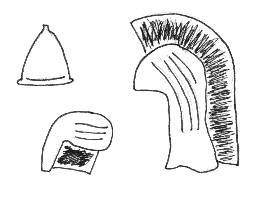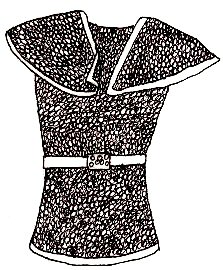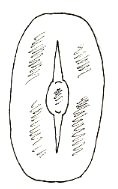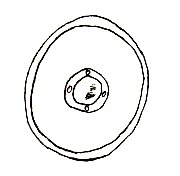The Iberian Peninsula is now known as modern Spain and Portugal and as in bygone centuries is a gateway to North Africa. People moved back and forth between Africa and Europe through the region, resulting in a unique mix of cultures that ranged from the Greek to Carthaginian to Celtic. Despite this broad range of cultures existing in Iberia, the original inhabitants were a collection of tribes with ancestry that was both native to Spain as well as Celtic. They were famous for their ferocious style of fighting and were often hired as mercenaries, especially by the Carthaginians.
In pitched battles the Iberians used a mixture of heavy and light infantry, who engaged the enemy with swords after a volley of javelins. This tactic proved to be highly successful and when combined with their formidable heavy cavalry made the Iberians a powerful force. Iberian swords were renowned for their strength, power, and durability, especially the falcata, which was their most famous and feared weapon. In addition they fielded other original weapons such as the espasa and the saunion. Many of the weapons used by the Iberians were of such high quality that several were adopted by the Romans for use by their legionaries, the gladius and pugiobeing descendents of Iberian blades. Without a doubt Iberian swords were among the finest manufactured in the ancient world. The Iberians were also famous for their use of guerrilla warfare. Their ability to disappear into the hills and return to strike at will made them a powerful force and parts of Northern Spain resisted Roman conquest until well into the late 1st century BC.
Defensive Equipment – A great variety of armor was used in the Iberian ranks, ranging from chain mail to scale. Locally built pieces were common, as well as captured Roman pieces. Shields were used by infantry and cavalry, the types used giving names to the soldiers that used them. One form of armor that is not listed here is scale, which was used by some Iberians.
Headgear
The type of helmet the ancient Spanish used mostly was a style named after them. The Iberian style was a simple conical bronze helmet that covered the top of the head, and proved to be popular with the Carthaginians as well. In addition some Celtic helmets were worn by Celt-Iberians, plus captured Roman examples were not uncommon among Iberians servering in Carthaginian armies. In general though helmets were rare. The main headgear among Iberians was a sinew hat that came in two different styles: hood and skullcap. The hood was larger and hung to the soldier’s shoulders and could be fitted with a crest, while the skullcap was smaller and fitted around the man’s crown, nape, and temples.
Chain Mail
Chain mail of the Celtic style was worn by some Iberian warriors, and by elite Celt-Iberians from Northern Spain. While used it does not seem to have been overly common among the troops of the Iberian Peninsula. In general pectorals appeared to be much more popular.
Pectoral
Simple breastplates were used by many cultures in ancient times, and the Iberians were no exception. Shapes could vary, from round to square, and sometimes they were elaborately decorated with raised images. Generally the pectorals were worn using a set of four straps, one going over each shoulder and another pair around the man’s torso. Roman pectorale were used by Iberians, who plundered them off Roman corpses in Iberia and when under Carthaginian command during the Punic Wars.
Scutum
Originally Italian, the large oval scutum was popular with the Iberians as well. Like the Celts their version was flat, unlike the Roman curved example. The heavy infantry who used the scutum in battle garnered the namescutarii thanks to their use of the shield. As with the Roman and Celtic examples, the Iberian scutum had a large spindle-shaped boss that could be used to punch opponents.
Caetra
Lighter Iberian troops such as javelin throwers as well as cavalrymen used the caetra, a round buckler. Featuring a central hand boss, the caetra measures roughly 2 feet across in the largest examples. Infantry who used the caetra were known as caetrati by the Romans and were fearsome in close combat when armed with afalcata or espasa.
Bladed Weapons – Swords were among the main weapons of Iberians, who manufactured a high-grade iron that is considered steel by many experts. Iberian swords were feared for their power and durability. The falcata was the most common sword, while the espasa was more rare but made a huge impression on the Romans, who adopted it, along with an Iberian dagger that went on to become known as the pugio.
Falcata
The most famous Iberian weapon of all, the falcata is a descendent of the Greek kopis, itself a related to the ancient Egyptian khopesh. Made of an early form of steel, the falcata was an incredibly powerful weapon, due in large part to its triangular shaped blade. It earned a fearsome reputation for being able to crush helmets, chop through shields, and remove limbs, especially among the Romans, who gave us its common name. Amazingly, the blade was only 15 to 20 inches long, but the power made the falcata the weapon of choice for Iberian soldiers of all arms.
Espasa
While it is not the most famous of Iberian weapons when using its original name, the espasa is without a doubt the greatest of ancient Spanish arms for one simple reason: Rome used it. The espasa was a simple iron short sword, roughly 25 inches long with a double-edged blade. The Romans’ initial encountered it during the First Punic War was both brutal and impressive. Espasas were lethal when the point was used and was just as deadly when swung, taking off arms and heads with ease. The Romans quickly adopted the espasa, which they called the gladius hispaniensis. The Iberian Peninsula was finally conquered by Roman troops using swords of Iberian origin.
Long Sword
Celtic long swords were used by some of the more northern Iberian peoples, including the Celt-Iberians. Roughly 3 feet long they were used by rich individuals who could afford the cost of producing one of these powerful weapons. Used for slashing, long swords were powerful enough to chop through armor deep into opponents.
Dagger
The gladius was not the only weapon the Roman legionnaires used that came from Iberia. The pugio, a light dagger worn by Roman troops was Iberian in origin. Measuring roughly 14 inches long, the pugio was made of iron and had a sharp double-edged blade. Iberian troops wore the pugio on their right side, opposite the falcataor espasa they wore on their left. It combat it was used as a final back-up weapon or for killing wounded opponents.
Knife
A small utility tool that could be quickly used as a last ditch weapon in a pinch, the small falcata-style knife was essentially a smaller version of the sword. Roughly 8 to 10 inches long, the knife had the same triangular blade as the falcata and was usually carried in a sheath attached to the falcata scabbard.
Pole Arms – The Iberians used a spear as one of their main weapons, but javelins, particularly specialized ones were used in large numbers. The saunion is a uniquely Iberian weapon.
Spear
For short range combat the Iberians used a long bladed spear, roughly 7 feet long. The iron spearhead was thin and light enough to allow the spear to be thrown if necessary. Shorter than most spears, the Iberian spear was suited to the close combat style that they practiced, as well as being admirably suited to their guerilla tactics. The cavalry also used the spear, along with a caetra, while the heavy infantry used the scutum with it.
Saunion
The Iberians fielded a heavy javelin known as a saunion, made completely out of iron. Measuring roughly 5 to 6 feet long, the saunion was heavy enough to punch through shields and continue on into the soldier holding it. Known as the soliferrum by the Romans, the saunion was a very common piece of equipment among the Iberian infantry and is unique to them.
Pilum-style Javelin
The Iberians used a form of javelin similar to that used by the Romans, specifically the light pilum. A socketed iron javelin-head with a long, thin neck was used, fixed to a shaft. When thrown the weapon would punch through the enemy’s shield, at the very least rendering the shield worthless or at best hitting the opponent.















I might be late commenting here, but I'd like to just point out that in fact it seems most Celtic individuals could afford a sword of considerable length.
This comment is currently awaiting admin approval, join now to view.